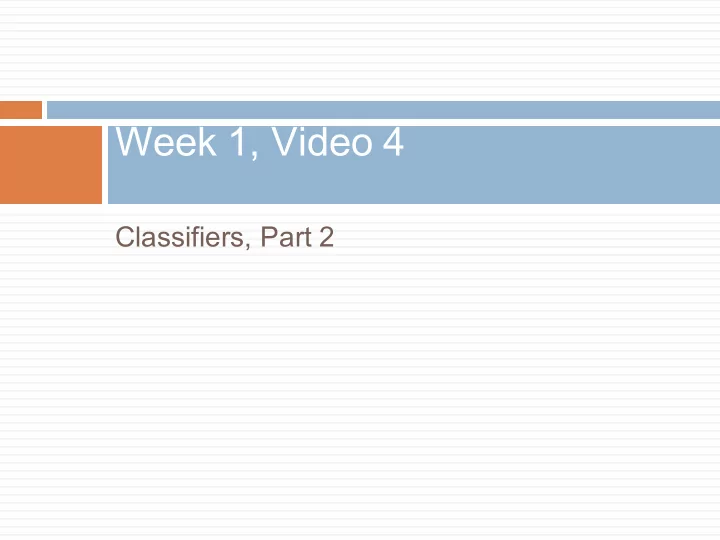

Week 1, Video 4 Classifiers, Part 2
Classification ◻ There is something you want to predict (“the label”) ◻ The thing you want to predict is categorical � The answer is one of a set of categories, not a number
In a Previous Class ◻ Step Regression ◻ Logistic Regression ◻ J48/C4.5 Decision Trees
Today ◻ More Classifiers
Decision Rules ◻ Sets of if-then rules which you check in order
Decision Rules Example ◻ IF time < 4 and knowledge > 0.55 then CORRECT ◻ ELSE IF time < 9 and knowledge > 0.82 then CORRECT ◻ ELSE IF numattempts > 4 and knowledge < 0.33 then INCORRECT ◻ OTHERWISE CORRECT
Many Algorithms ◻ Differences are in terms of how rules are generated and selected ◻ Most popular subcategory (including JRip and PART) repeatedly creates decision trees and distills best rules
Generating Rules from Decision Tree Create Decision Tree 1. If there is at least one path that is worth keeping, go to 3 else go 2. to 6 Take the “Best” single path from root to leaf and make that 3. path a rule Remove all data points classified by that rule from data set 4. Go to step 1 5. Take all remaining data points 6. Find the most common value for those data points 7. Make an “otherwise” rule using that 8.
Relatively conservative ◻ Leads to simpler models than most decision trees
Very interpretable models ◻ Unlike most other approaches
Good when multi-level interactions are common ◻ Just like decision trees
kNN ◻ Predicts a data point from neighboring k data points � Takes the most common label among those k points � Take kNN with k=5 for example
Blue with 80% confidence
K* ◻ Predicts a data point from neighboring data points � Weights points more strongly if they are nearby
Good when data is very divergent ◻ Lots of different processes can lead to the same result ◻ Intractable to find general rules ◻ But data points that are similar tend to be from the same group
Big Advantage ◻ Sometimes works when nothing else works ◻ Has been useful for my group in detecting emotion from log files (Baker et al., 2012)
Big Drawback ◻ To use the model, you need to have the whole data set
Later Lectures ◻ Goodness metrics for comparing classifiers ◻ Validating classifiers ◻ Classifier conservatism and over-fitting
Next Lecture ◻ A case study in classification
Recommend
More recommend